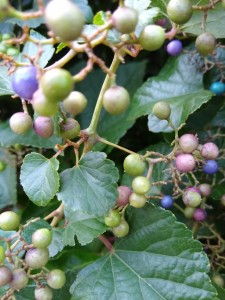“Ampelopsis” sounds like something out of a children’s book. I can imagine a large, lumpy monster—possibly friendly, but definitely massive. Ampelopsis brevipedunculata is a monster, but not of the animal kind. Better known as porcelain berry or Amur peppervine, it is a non-native vine that grows rapidly, spreads like wildfire and dominates everything in its path.
This does not sound like an attractive combination of traits, but, in fact, porcelain berry is a very attractive plant. It is a member of the grape or Vitaceae family and kin to native wild grapes. The dark green, tri-lobed leaves can easily be mistaken for those of wild grapes, as can the relatively insignificant greenish flowers that bloom in the leaf axils or spaces where leaves and stems meet. Like wild grape, porcelain berry climbs, making its way upward with the help of spiraling tendrils that reach out and grab any available support. The vines can grow 15 to 25 feet, going right up and over fences, trellises, garages or even large shrubs. Like that southern menace, kudzu, it would probably envelope a stationary human, if that individual stood still for too long.
Porcelain berry’s most distinctive feature is its fruit. Those insignificant flowers give way to small round berries that start out pale lilac and gradually deepen in color to porcelain blue. The berries ripen at different times, so each cluster features a full complement of small, ovoid berries in eye-catching Easter egg colors. A good flower arranger could incorporate the berries into a stunning arrangement. Left on the vine, they are gorgeous against the backdrop of those shapely grape-like leaves.
I was out on a walk last week and saw a vigorous porcelain berry that had almost completely taken over a rather attractive variegated euonymus. A few green and chartreuse leaves were still visible, attempting to escape from the vine, but for the most part, the euonymus had become little more than a support structure for the porcelain berry.
Like so many plants that have gotten out of hand, Ampelopsis brevipedunculata arrived in the United States from its Asian native areas in the late nineteenth century—1870 to be exact—because its champions thought it might make a useful and beautiful ornamental plant. The Victorians loved their vines, so porcelain berry fit right in with the horticultural zeitgeist. Once the vines were planted in gardens, birds did their part in facilitating their escape. The gorgeous fruits are apparently delicious to the winged denizens of our backyards. Eaten, digested and secreted, they sprout readily almost anywhere. This year in my yard, I have pulled up nascent porcelain berry vines every time I have weeded my beds and borders. I don’t even know where the parent vine lived or lives, but my intruders probably got their start in some neglected patch elsewhere in the neighborhood.
Some retailers still sell porcelain berry, despite its bad reputation. A very old cultivar, ‘Elegans’ features somewhat smaller leaves than the species and those leaves are variegated with cream or very pale green. Under the right conditions, the variegated areas may turn a bit pink. According to woody plant guru Michael Dirr, ‘Elegans” is “not as vigorous as the species and would be a good choice for locations where the species is too aggressive.” All of that might be true, but I am not sure I would take the risk in my garden.
The well-regarded plant finder website of the Missouri Botanical Garden has placed the warning, “Midwest noxious weed: Do not plant” in big red letters at the top of the page for Ampelopsis brevipedunculata. The Invasive Plant Atlas of the United States shows at least 10 states where porcelain berry is listed on invasive species lists or covered under invasive species laws. All the states are in the northeast, where the vine is busy outcompeting weaker species, including vulnerable native plants. In fact, the only thing that can stop porcelain berry is the common garden aphid, which apparently loves to feast on the leaves. Still, there are not enough aphids in the northeastern United States to halt the progress of this muscular vine.
The vines are deciduous, so if you don’t pluck them out of the ground when they appear, they will flourish through the growing season, lose their leaves in fall and return the following spring. In the meantime, birds will have spread the seeds far and wide.
Porcelain berry is not fussy about its environs, but makes the most progress in sunny or partly sunny locations, especially where moisture is consistent. If I neglect the weeding for even a week, I can count on finding at least ten new plants, especially in parts of the garden that I leave for last on the perpetual weeding roster.
I will not tell you where to buy the plants, because no one should buy or sell them. If you see porcelain berry, don’t wait to pull it out and don’t feel guilty. I guarantee that even as you grasp the young vine, another one will be popping up on your neighbor’s property.

